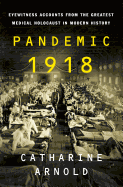
Each year, up to 20% of the population will get the flu. Most individuals will recover with no complications. A small percentage will require hospitalization, and an even smaller percentage (usually the very young or the very old) will die. In 1918, at the end of World War I, this was not the case; more than one-third of the world's population caught the pandemic Spanish flu. Popular historian and journalist Catharine Arnold (Necropolis: London and Its Dead) follows the course of a virus that killed 25 million people in its first 25 weeks and more than 50 million people worldwide. Medical historians would call it the greatest medical holocaust in history--deadlier than the Great Plague.
Spanish flu struck down politicians and average Joes with equal intensity, differing from seasonal influenza by killing the young and healthy, rich as well as poor: "Indeed, by the end of the war, more Americans would have died from Spanish flu then perished in the war." Spanish flu made orphans out of 600 children in New York, caused a shortage of coffins and gravediggers in Philadelphia and turned Armistice Day into a protracted death march.
Arnold painstakingly reviews eyewitness accounts from survivors, diaries, newspaper reports and military and medical records. Spanish flu continued to haunt researchers nearly 80 years later, when tissue samples from excavated remains revealed it to be a form of avian flu, and when prospects of another epidemic loomed heavily on the horizon.
A 1918 London Times quote sums up the impact of the Spanish flu: "Never since the Black Death had such a plague swept over the world; never, perhaps, has a plague been more stoically accepted." --Nancy Powell, freelance writer and technical consultant

